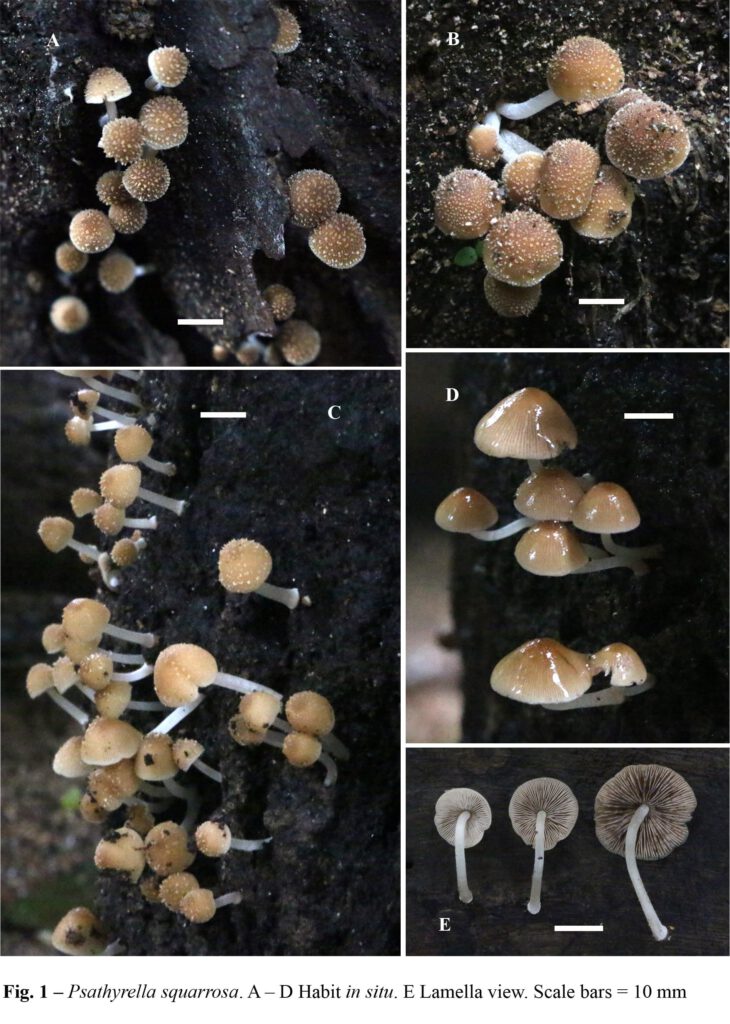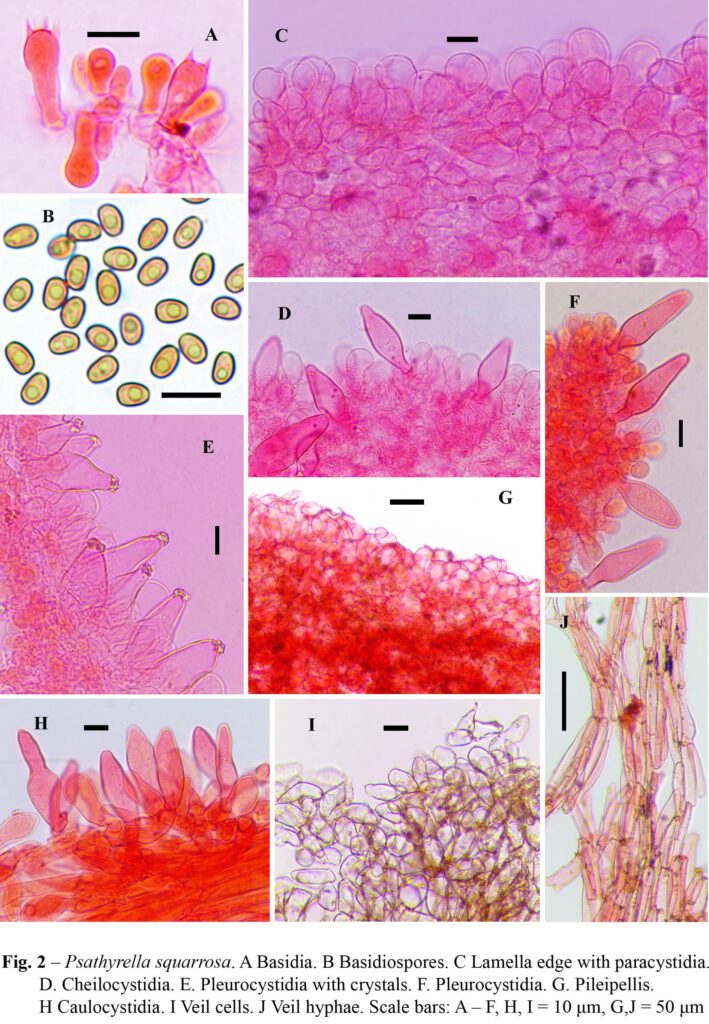Psathyrella squarrosa T. Bau & J.Q. Yan.
MycoBank number: MB 824883; Index Fungorum number: IF 824883; Facesoffungi number: FoF 10835;
Description
Basidiomata small, up to 52 mm high, fragile. Pileus 3–21 mm diam., parabolic in buds, becoming conical, convex to broadly convex with or without a small obtuse umbo at centre; surface brown to dark brown (6E5/6F5) in buds with off white to yellowish white (4A2) upright to recurved velar squamules throughout, vanishing when mature or on handling; later become brownish orange to light brown (5C4/5D5/5D6) in mature basidiomata, pellucid striate up to the disc, with or without velar remnants, moist to dry, hygrophanous; margin straight, entire to incised. Lamellae adnexed, yellowish white (4A2) in buds, later become greyish orange to brown when mature (5B3/5C3/6D3/6D4/6E4), up to 2.5mm wide, crowded with lamellulae of 3–4 lengths; edge white, minutely fimbriate. Stipe 8–50 × 1–2.5 mm, central, cylindric, hollow, curved, equal with a slightly broad base, brittle; surface white, turning brownish orange (5C4) on keeping, floccose throughout in buds, vanishing on handling; base with white strigose hairs and mycelial mat. Context thin, white up to 1 mm thick at the disc, soft. Odor mild, not distinctive. Spore print dark brown (7F5). Basidiospores 6–6.4 × 3.6–4 µm (avL=6.12µm, avW=3.72 µm), Q1.5–1.87 µm (Qm=1.55µm), ellipsoid to elongate, subphaseoliform, brownish orange in water, greyish brown in 3% aqueous KOH, fading in concentrated H2SO4, thick-walled, smooth, germ pore indistinct. Basidia 16.4–19.2 × 6–7.2 µm, clavate, 2, 4- spored, thin-walled, hyaline. Gill edge sterile with both cheilocystidia and paracystidia. Cheilocystidia scattered, scarce, 20–34.6 × 11.2–15.2 µm, utriform to broadly utriform with obtuse to subobtuse apex, slightly thick-walled, hyaline, apex with crystals, dissolving in 3% aqueous KOH. Paracystidia crowded, 14–32 × 10–22 µm, clavate, broadly clavate to vesiculose, thin-walled, hyaline. Pleurocystidia abundant, scattered, 33–46 × 9.6–15 µm, similar to cheilocystidia, narrowly utriform, to very broadly utriform, with broadly obtuse apex, rarely with subcapitate to bifurcate apex, thick-walled with abundant crystals at apex, dissolving in 3% aqueous KOH. Hymenophoral trama regular, hyphae 3.2–18 µm broad, inflated thin-walled, hyaline. Subhymenium pseudoparenchymatous. Pileal trama composed of thin-walled, hyaline, branched, inflated, 4–36 µm broad hyphae constricted at septa. Pileipellis is an epithelium composed of globose to subglobose cells, 26–65.6 × 25.6–41.5 µm, thin-walled, hyaline. Stipitipellis composed of thin-walled, hyaline, 4–14 µm broad hyphae with clamp connections. Stipe contains both caulocystidia and paracystidia throughout. Caulocystidia in clusters, crowded at the stipe apex, abundant, 22.4–52 × 8–12.8 µm, versiform, lageniform to narrowly utriform, utriform, flexuous with acute, obtuse, broadly obtuse, mucronate to rostrate apex, slightly thick- walled, hyaline, apex with crystals, dissolving in 3% aqueous KOH. Paracystidia in clusters, crowded at the apex, abundant, 20–28 × 10–13.6 µm, clavate, thin-walled, hyaline. Oleiferous hyphae present in all tissues. Velar squamules consists of both hyphae and subglobose to ellipsoid cells; 43.6–19.2 × 4–22.8 µm, thin-walled, hyaline; hyphae, 3.2–20 µm wide, hyaline, thin-walled with clamp connections.
Material examined:India, Kerala State, Thiruvananthapuram district, Palode, JNTBGRI campus, 19 Sep 2021, TBGT(M)18694; ibid., 20 Sep 2021, TBGT(M) 18695; ibid., 04 Oct 2021, TBGT(M)18713; ibid.,11 Oct 2021 TBGT(M)18718; ibid., 29 Oct 2021, TBGT(M)18737; ibid., 2 Nov 2021, TBGT(M)18738; ibid., 03 Nov 2021, TBGT(M)18741; ibid., 05 Nov 2021, TBGT(M)18743; 10 Nov 2021, TBGT(M)18745; ibid., 11 Nov 2021, TBGT(M)18748; ibid., 19 Nov 2021, TBGT(M)18751; ibid., 30 Nov 2021, TBGT(M)18752; 2 Dec 2021, TBGT(M)18753.
Distribution: Scattered to gregarious on dead angiosperm wood in tropical evergreen forest, Kerala State, India. September – December. It is so far known only from the type locality in China.
Sequence data: ITS: OM301743 (ITS1/ITS4).
Notes: The Indian collections match with the type description both morphologically and molecularly (Bau & Yan 2021). Additional features observed in the Indian collections include: strigose stipe base and mycelial mat; abundant thin-walled clavate, vesiculose paracystidia in the lamella edge; abundant pleurocystidia with crystals at apex, but lacking yellow deposition at apex and versiform caulocystidia intermingled with thin-walled paracystidia. The discovery of Psathyrella squarrosa from India is significant as it is so far known only from the type collections in China. This report thus forms the first ever report of this species outside the type locality and is phytogeographically significant.


